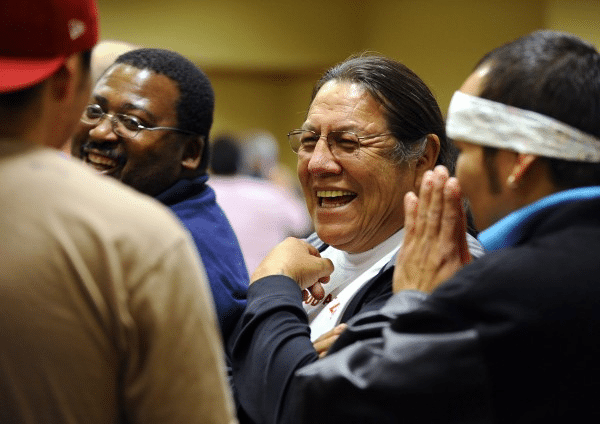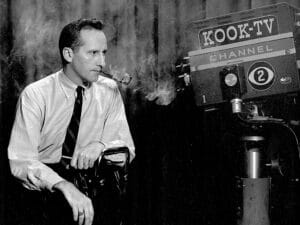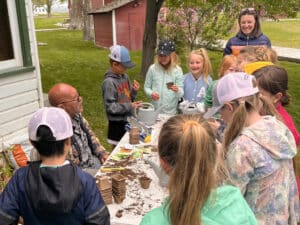Grantee: Dee Garceau of Dance River Productions and the Foundation for Montana History
Award: $10,000 Film + Video award to support production of a documentary film
Project: A Different, Deadly Beast: The 1918 Influenza in Montana
Can you give a brief history of your Humanities Montana-supported project?
During the Covid winter of 2020-21, I became curious about how past pandemics had affected Montanans. I wondered, could that make an engaging film? Historian Lori Lahlum, intern Ashby Glover, and I spent a year as a remote research team investigating the 1918-19 influenza. We explored letters, newspapers, diaries, memoirs, and oral histories from across Montana. We found that few wanted to remember a pandemic; most sources had only a line or two, if that. Despite near silence on the influenza, we did discover six compelling stories that also mirrored the diversity of this region. A Finnish immigrant, a Blackfeet couple, a white nurse, a Crow law school graduate, an African American entrepreneur, and a boy in a small railroad town became the focus of our film.
In Spring 2021, we developed a crowd-sourcing website in our first attempt to raise funds for the project. During Fall-Winter 2021, I partnered with the Public History Program at the University of Montana to offer a Film Internship for History majors and graduate students. U.M. interns Kevin Mobley and Kym MacEwan came on board. Kevin and Kym gained experience interpreting firsthand narratives, developing historical context to frame them, scripting voiceovers from archival sources, and storyboarding this content.
By Spring 2022, having conceptualized our six stories in more depth and detail, we turned to writing grants. From Spring through Summer 2022, we completed six grant applications, and were awarded funding by four: Humanities Montana, the Greater Montana Foundation, the Montana Film Office, and Treasure State Studios of Missoula. We thank these organizations for their generous support of this project.
Production began in the Fall of 2022, with a talented crew. John Nilles, a filmmaker in his own right, and Josef “Tuna” Metesh, a sound engineer and skilled cinematographer, became our Director of Photography and Camera B, respectively. We also partnered with Blackfeet elders Leon Rattler and Cheryl Cobell Zwang, and Crow elder Reno Charette to tell the indigenous stories within this film. Former intern Ashby Glover was promoted to Assistant Producer. And two new U.M. film interns came on board, Ginger Duncan and Chad Keller. From September through December, we filmed locations, landscapes, and weather, staged reenactment scenes, recorded voiceovers scripted from personal narratives, and interviewed scholars, relatives, and elders, who added depth and dimension to the six stories. We wrapped production December 15, 2022!
As we head into Spring 2023, we begin editing footage to build the stories. We expect to complete our final cut by June 30, 2023. Distribution plans include submitting the finished film to Montana PBS, from whom we have a letter of interest. We also will apply for a Humanities grant to bring the finished film to the Montana communities who gave us stories, inviting audiences to participate in discussion after each screening. Finally, we will enter the documentary in a handful of major film festivals, in Toronto, Austin, Memphis, New Orleans, and Kansas City.
In your opinion, what was the most notable accomplishment of your project?
First, we discovered themes of community and resilience amid the pandemic, a lethal virus that swept through Montana before vaccines were available. We believe this film will inspire discussion, not only of the fear and trauma that accompany an epidemic, but also of the ways people worked together to meet the challenge of a public health crisis.
Second, the six stories will highlight ethnic, gender, racial, and cultural diversity, expanding public perception of who makes history in Montana. Third, we think these stories will invite viewers to reflect on our common humanity: When and how do we step outside our comfort zone to help a neighbor? To nurture a community? What is the role of storytelling in healing trauma? What fuels courage in trying times?
Finally, when a crew works well together, as ours did, it makes the work a joy. Filmmaking is collaborative; when cinematographers, cultural advisors, directors, assistants, and interns work as a creative team, the experience becomes its own reward and the film gains depth and nuance.
What lessons did you learn along the way?
I offer the following for up-and-coming filmmakers:
- Budget more than you think you will need. There will be unforeseen costs, from vehicle repair to unexpectedly high hotel, fuel, or Airbnb prices.
- DO take time to research expenses. What is the going rate for a Director of Photography? For a Cultural Advisor? For an Assistant Producer? For an Airbnb in a small town? For a hotel room in a larger city? Craft a detailed, well-informed budget.
- When best-laid plans go awry (due to weather, for example), roll with it. Find a way to make it work, with who and what are available and/or with rescheduling. DP John and I have a saying, “We’ll make it work.” We would say this to each other to calm ourselves, regroup, and problem-solve.
- Look for serendipitous shots. Part of documentary filmmaking is planned, part involves discovery along the way. We had the good fortune to film an approaching storm over the plains, in White Sulphur Springs. Later, as we walked through town, we noticed an abandoned building flanked by a tall pine. It suggested a visual metaphor so we filmed it. So, too, filmed interviews will yield nuggets of insight, unforeseen stories, and new perspectives. Good interviewing requires open-ended questions, sustained listening, and apt follow-up questions, to draw out those gems.
- Take creative risks. Don’t be afraid to make mistakes. Making an independent film is an act of faith based on careful work and planning, but the best footage can be the unexpected. Be present and open to that.
- Mentor others. Bring one or two apprentices or interns on board at a time. Share knowledge, responsibilities, and encouragement as you and your crew move through pre-production, production, and post-production. They will gain valuable experience.
What’s your definition of the humanities?
The Humanities explore what it is to be in relationship – – with each other, with ourselves, with the natural environment, and with the built environments. We connect with films, books, performances, lectures, readings, or workshops that mirror our dreams, our vulnerability, our challenges, our choices, our values, and our decisions in ways that open our eyes and hearts. The Humanities expand our perceptions of what matters.
What advice can you offer to future Humanities Montana grantees?
Follow the instructions for each grant. That sounds obvious, but it makes a difference. When presenting your treatment, or addressing questions about Humanities content, be concise yet precise. That is, explain enough to get beyond generalities. At the same time, limit details to only those most evocative. Be sure to explain what sets your project apart: What new question are you exploring? How is your approach different from what has been done before? Let your passion for the project come through. Why does this topic move you? Let them know. Finally, proofread and edit. You’ll realize what you’re saying, and then you’ll say it better.
How can readers learn more about your project?
You can visit our website at https://1918mtinfluenza.com/
Or follow us on Facebook at https://www.facebook.com/docfilm1918mtflu
If readers have questions, you are welcome to contact me at rivergirl300@gmail.com




